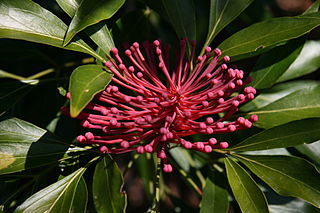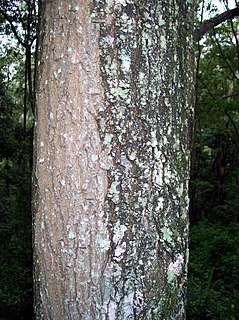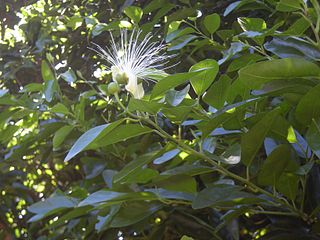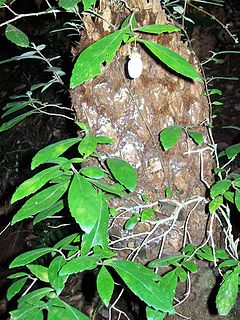
Nothofagus moorei, commonly known as Antarctic beech, is an important Gondwana relict of the rainforests of the southern hemisphere. It occurs in wet, fire-free areas at high altitude in eastern Australia.

Alloxylon pinnatum, known as Dorrigo waratah, is a tree of the family Proteaceae found in warm-temperate rainforest of south-east Queensland and northern New South Wales in eastern Australia. It has shiny green leaves that are either pinnate (lobed) and up to 30 cm (12 in) long, or lanceolate (spear-shaped) and up to 15 cm (5.9 in) long. The prominent pinkish-red flower heads, known as inflorescences, appear in spring and summer; these are made up of 50 to 140 individual flowers arranged in corymb or raceme. These are followed by rectangular woody seed pods, which bear two rows of winged seeds.

Drypetes deplanchei is a tree of eastern and northern Australia. It also occurs in New Caledonia and Lord Howe Island. The genus is derived from the Greek, dryppa meaning "olive fruit". The species named after Dr. Emile Deplanche, who collected this plant at New Caledonia. Common names include yellow tulip, grey boxwood, white myrtle, grey bark and yellow tulipwood.

Bridelia exaltata, known as the brush ironbark or scrub ironbark, is a tree of eastern Australia. It occurs in and on the margins of the drier rainforests. Also occurring by streams, often in association with the Black Bean, up to an elevation of 600 metres above sea level. It occurs from Seal Rocks, New South Wales to Maryborough, Queensland.

Gossia acmenoides, known as the scrub ironwood, is a rainforest tree of the family Myrtaceae, native to eastern Australia. The usual habitat of this small tree is drier rainforest areas. The range of natural distribution is from Jamberoo in New South Wales to Eungella National Park in northern Queensland.

Capparis arborea is a bush or small tree occurring in eastern Australia. The habitat is rainforest; usually riverine, littoral or the drier rainforests. Distributed from the Hunter River, New South Wales to Cape Melville in tropical Queensland. Common names include native pomegranate, wild lime, wild lemon and brush caper berry.

Astroloma pinifolium, commonly known as pine heath, is small prostrate shrub or groundcover in the family Ericaceae endemic to eastern Australia.

Baloghia marmorata is a rare rainforest plant of eastern Australia. It is commonly known as the marbled baloghia.

Randia moorei, commonly known as the spiny gardenia, is a rare Australian shrub growing in the far north eastern areas of the state of New South Wales and adjacent areas in Queensland. The habitat is subtropical rainforest north of Lismore.

Pseudoweinmannia lachnocarpa is a rainforest tree of eastern Australia. Common names include rose marara, mararie, scrub rosewood and red carabeen. The species name lachnocarpa is from the Greek, referring to the "woolly fruit". The genus name refers to the similarity of another genus, Weinmannia, after the German eighteenth century pharmacist J.W. Weinmann.

Ochrosia moorei, known as the southern ochrosia is a rainforest plant of eastern Australia. Endangered by extinction, it has a ROTAP rating of 2ECi.

Phyllanthus microcladus is a plant found in sub tropical areas of eastern Australia. The brush sauropus is listed as endangered by extinction. It occurs by streams in sub tropical rainforest, from as far south as Grafton, New South Wales to the south east rainforest areas of Queensland. Most often seen in the valleys of the Brunswick, Richmond and Tweed Rivers in far north eastern New South Wales.

Decaspermum humile, commonly known as the silky myrtle, is a tree from Australia and Asia. It can be used as bush food, as indicated by the alternate common name of currant myrtle. The tree features an attractive dark glossy crown. The new pink leaves with silvery hairs are particularly appealing.

Planchonella queenslandica, the blush condoo, is a large rainforest tree of the family Sapotaceae native to eastern Australia. It's found in sea side rainforest as well as the drier inland rainforests. From as far south as the Richmond River, New South Wales to Coen in tropical Queensland, and as far west as Melville Island, Northern Territory.

Fieldia australis, usually referred to as fieldia is a small climbing plant or epiphyte found in eastern Australian rainforests. Commonly seen in the cooler rainforests at higher altitudes. It also grows in the warmer rainforests with a high humidity. The plant uses adventitious roots to grip hold of tree trunks, mossy rocks or tree ferns.

Uromyrtus lamingtonensis is a rare Australian shrub growing around the state border of New South Wales and Queensland. Like the Peach Myrtle, it has attractive pink flowers.

Pouteria myrsinoides is an Australian tree in the family Sapotaceae. The common names include yellow plumwood, axe-handle wood and blunt-leaved coondoo. It occurs in seaside rainforests and drier rainforests from the Forster, New South Wales to the Lakeland Downs in tropical Queensland. The subspecies reticulata occurs on Lord Howe Island and in New Caledonia.

Rhodamnia whiteana, known as the cliff malletwood or White's malletwood is a sub-tropical rainforest plant of eastern Australia.

Drymophila cyanocarpa, also known as turquoise berry or native Solomon's seal, is a species of flowering plant in the family Alstroemeriaceae. It is a herbaceous perennial, growing up to 60 cm in height. Leaves are 3 to 8 cm long and 5 to 15 mm wide. Pendant white, cream or light mauve flowers appear between November and January in the species' native range. These are followed by blue to purple ovoid berries that are between 5 and 10 mm long. It occurs in the Australian states of Tasmania, Victoria and New South Wales.

Gossia fragrantissima, the sweet myrtle or small-leaved myrtle, is a shrub or small tree of eastern Australia. A plant with a ROTAP rating of 3EC-, endangered by extinction. Found in sub tropical rainforests near streams, from near Woodburn, New South Wales to Nambour in south eastern Queensland. It features fragrant flowers, hence the specific epithet fragrantissima. White flowers grow from October to February.





















